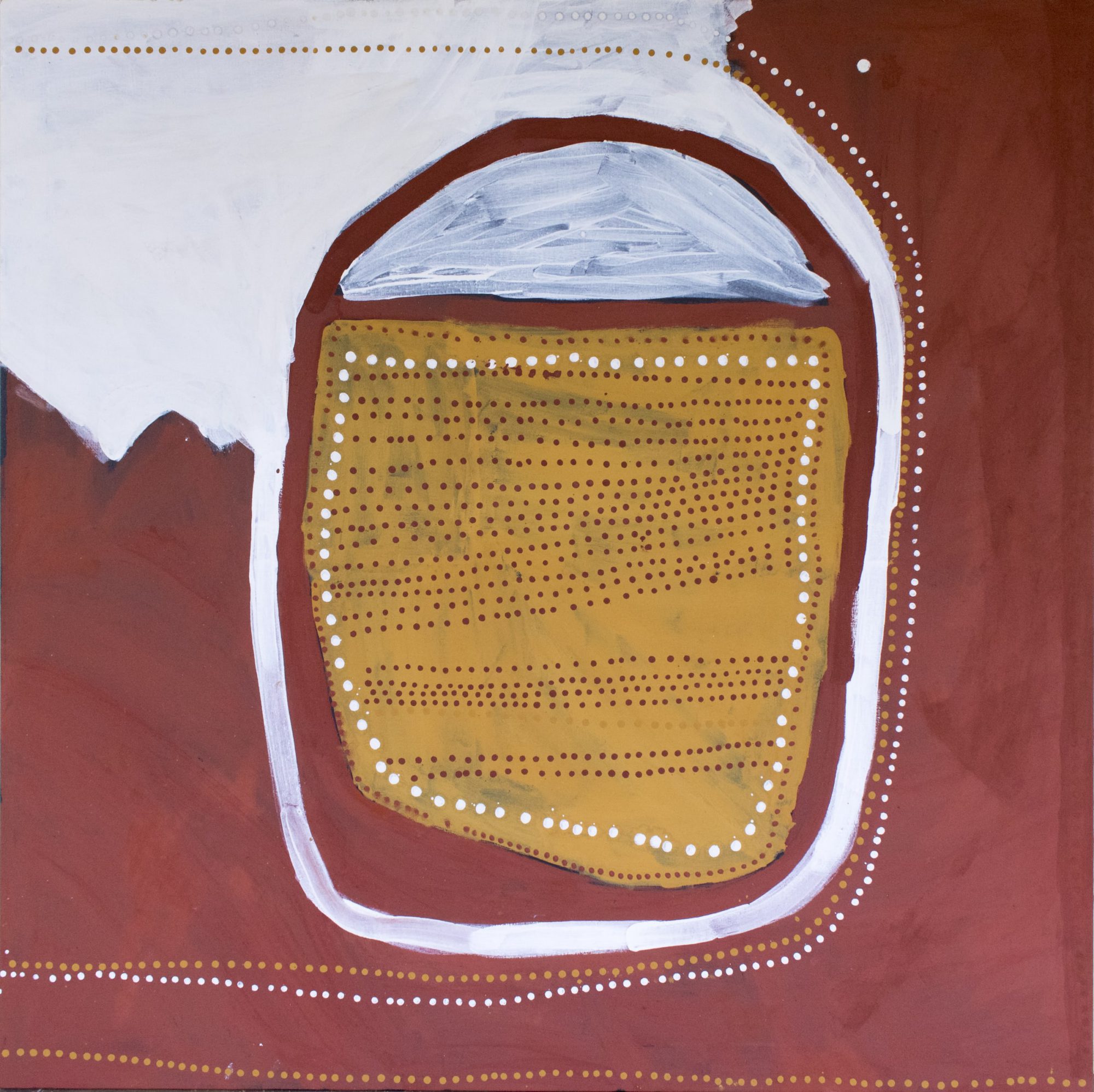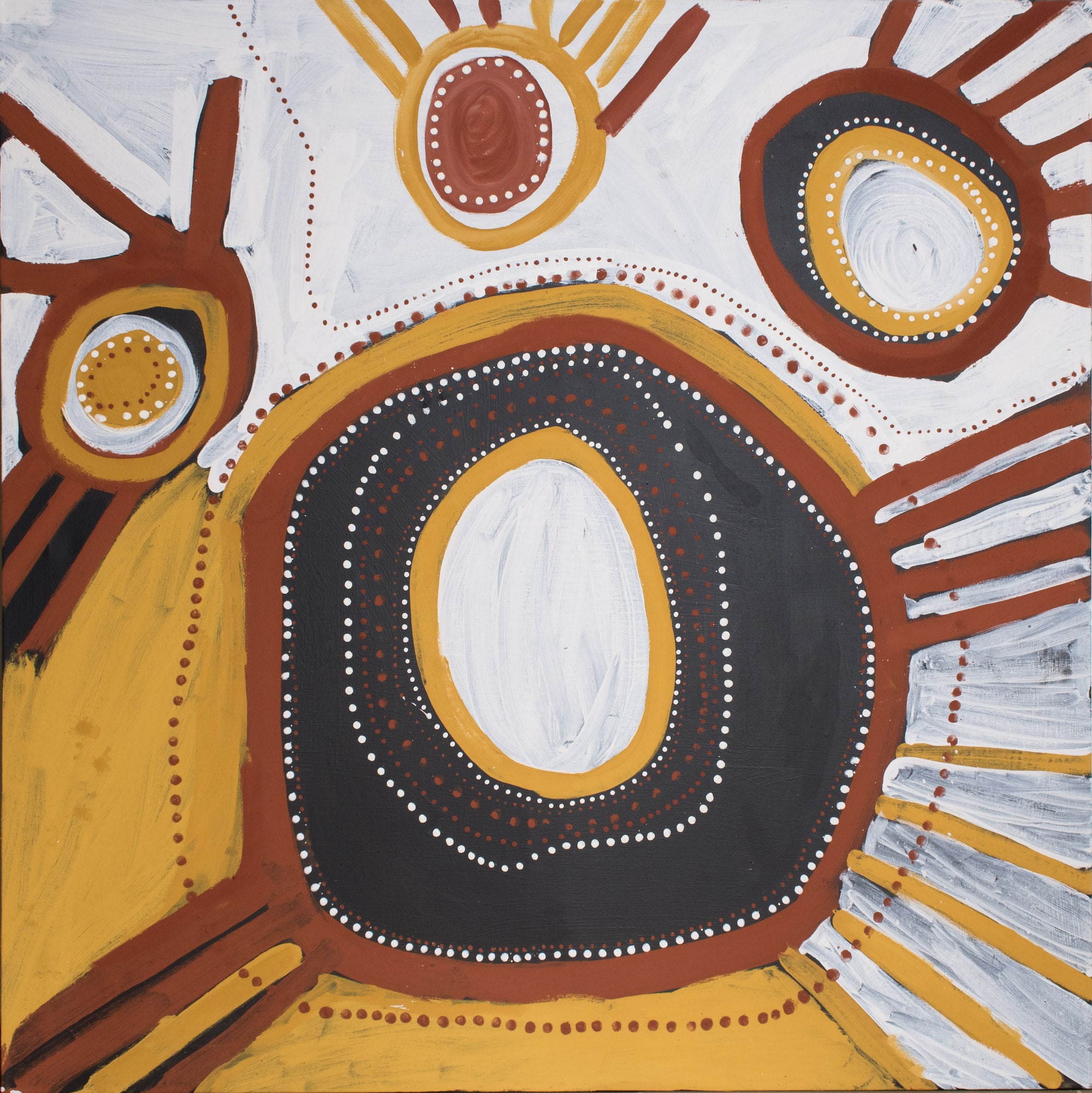
Exhibition Essay
“Dino Wilson: Kurluwukari, Marlipinyini amintiya Pwanga (circles, lines and dots) at Jilamara Arts and Crafts”
Will Heathcote, Studio and Workshops Coordinator, Jilamara Arts
Dino Wilson’s paintings are distinct and outline a very Tiwi story. Drawing on jilamara (body paint design), he creates bold compositions of kurluwukari, marlipinyini amintiya pwanga (circles, lines and dots) in turtiyangiari(natural earth pigments). In this way he comes after the likes of well-known Jilamara members: Kitty Kantilla, Freda Warlipinni, Timothy Cook and Conrad Tipungwuti, a cohort of artists that have resisted acrylic paints and embodied a gestural visual language. Like Kitty and Timothy before him, Dino does not use the iconic Tiwi pwoja comb to apply pwaga (dots). The uniform and repeated sequences of dots of which some Tiwi artists such as Pedro Wonaeamirri and Raelene Kerinauia have become so well-known are absent from his work. Instead the use of a variety of yirramitirrani (sticks) creates sequences of pwanga in a variety of sizes, forms and rhythms.
In the studio, Dino never ceases to surprise me with the new compositions and design elements that he conjures. This is evident in his large images of tunga (bark bags), where his broad strokes of ochre trace the outline of the object and dots of varying sizes illustrate the bag’s iconic side stitching and jilamara design. As he describes:
“I paint Tunga with circles and dots. A long time ago the old people used Tunga. They collected the bush tucker in it. They would carry it for a long time, it feels good thinking about what they used to do.”
Natural ochres are celebrated in Dino’s work, through gestural mark making and the earthy matt qualities of the natural pigments that are collected from around Milikapiti and processed by hand in the studios.
“My Country is Pickataramoor. We get the yellow ochre there and we burn it on the fire to make it red. I feel happy working with ochres, it makes me feel good because they have come from my country. The old people they do it from long time ago, before they pass away they pass it over for us – the new generation.”
Dino’s works primarily focus on four main subjects that are central to Tiwi cultural practice; tunga (bark bag), jaliwaki and murunga (local yams), wantaringuwi (sun) and Ngiya Murakupuni (my country). As he describes:
“I paint suns, sitting around the fire, my families’ different countries on the Tiwi islands and Jaliwaki (bush potato). They find jaliwaki around Paru and Pirlingimpi, it’s not the cheeky bush potato, you can eat it. The old people still eat it. Bush potato and tunga are my favourite things to paint because they are Tiwi… I like painting with ochre colours for the same reason, they are Tiwi and come from the island that I live.”
In many ways his paintings are new, different and interesting, but still contain the memory of their cultural origins and artistic heritage of previous Jilamara icons. As long time Jilamara member and governance figure Brian Farmer has explained: “My people didn’t have written text…it’s all done by painting. The story, like, it goes on from there…through painting is a way of remembering.”[1] Dino embodies this mentality, a language through painting that is both parlingarri (old) and ningani (new). Previous Jilamara coordinator James Bennett identifies Tiwi art as inherently innovative when he writes: “The Pukumani ceremony is closely connected to the notion of disguise…The need for ceremonial camouflage ensures that imagination and invention are key elements on each artist’s creative agenda.”[2] Innovation is at the centre of this Tiwi visual practice and Dino’s works are no exception. He utilises a distinctive pictorial language with materials sourced from the islands to create works that are imaginative, contemporary and also a testament to a long standing but still living cultural practice.
[1]Quoted in Judith Ryan, “Poetics of Intimacy: the art of Kitty Kantilla”, Kitty Kantilla, National Gallery of Victoria: Melbourne, 2007, p.75.
[2] James Bennett, “Kitty Kantilla’s Art and the ‘Old Designs’”, in Kitty Kantilla, National Gallery of Victoria: Melbourne, 2007, p. 90














